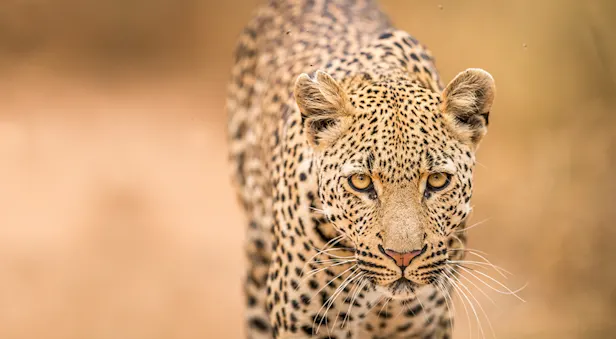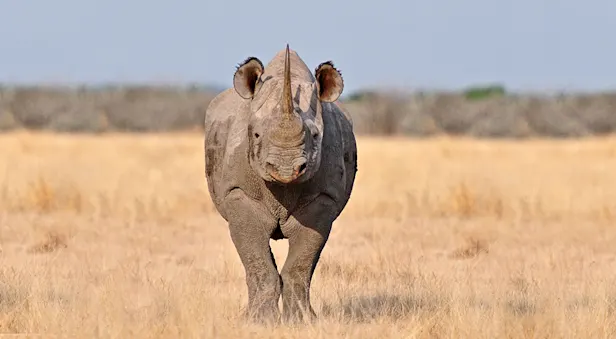Rhino Facts | Southern Africa Wildlife Guide
The rhinoceros has an ancient history, with skin that looks like plated armor from a bygone age. Their ancestors form part of a larger group that was previously distributed across the Americas, Eurasia and Africa; however, only five species remain today. Tragically, both the black and white rhinoceros that live outside of limited protected areas and reserves face imminent extinction in the wild. Demand for their keratin horns is leading the beast to the brink of extinction.
Rhino horns’ alleged pharmaceutical qualities as a nerve tonic and general restorative have supported relatively modest markets in the Far East. Most of the recent poaching in East Africa, however, has been driven by a demand for dagger handles, a male status symbol in countries such as Yemen. The unabated and apparently uncontrollable poaching problem is a greater burden than the rhino’s naturally low population density and slow reproductive rate can support.
Currently, the white rhino is less endangered than its cousin. Fortunately, because efforts in the last two decades to save the white rhino have been so successful in countries like South Africa, there are surplus white rhino being sold at wildlife auctions to help restock wildlife reserves. The black, or hook-lipped, rhinoceros is less common and is on the critically endangered list; some scientists agree that it may not survive beyond the next two decades on parts of the continent. No more than 2,000 currently exist, and the population is dwindling quickly.
Physical Characteristics
Both the black rhino and the white rhino are, in fact, gray.
The white rhino’s name is a corruption of the Afrikaans word for “wide,” referring to its broad upper lip, which is designed for grazing.
Black rhinos have longer necks than white rhinos, which help them to reach up into vegetation for browsing.
The white rhino’s relatively longer head enables it to reach the ground to graze.
Rhinos are odd-toed ungulates, like their close relative, the horse. They possess three large toes, which make a clearly recognizable footprint.
African rhinos possess two horns, the shorter one set behind the longer. They are distinct from their cousin, the Indian rhino, which has only a single horn.
The horns are not bone, but tightly packed bundles of hair-like structures, similar to hooves and toenails, mounted on roughened areas of the skull. Apart from this, rhinos are virtually hairless.
Habitat
Black rhinos range from moist forest to semi-arid bushland, whereas the white rhino prefers the drier environment of both grassland and wooded grassland. Within the white rhino’s African habitat, two distinct populations traditionally existed. The northern range extends west from Southern Sudan, through the Republic of Congo, towards Lake Chad. The southern species of the white rhinoceros occurs south of the Zambezi River. Between these two subspecies, marked differences occur—noted by the concavity of their foreheads. It is of deeply regrettable note, however, that the last male northern white rhinoceros died in March 2018 at the Ol Pejeta Conservancy in Kenya.
Behavior
The white rhino is a partly nocturnal creature. The black rhino is more strictly diurnal, however, may become partially or totally nocturnal in regions of persecution. Both species are fond of rolling on their sides in mud or dust wallows; they cannot roll on their backs because of the elongated, blade-like protrusions on their spines. They also frequently rub their bellies, flanks or faces on rocks and stumps; “polished” rubbing sites are seen throughout rhino country.
Rhino Society
Rhinos are not very sociable creatures, especially the black species. White rhinos, however, have been known to form small family groups, which can include several females and their young. White rhino females also often engage in friendly nose-to-nose greetings when they meet. In addition, this group appears to be more phlegmatic than their black cousins; two males may spend an hour staring at each other from a short distance, sometimes nose to nose, as if greeting, occasionally wiping their horns on the ground. They then turn around suddenly and trot back to the center of their perspective territories. Black males tend to be less amiable. Upon encountering each other, serious fighting can result if one rhino does not give way. Sometimes gaping wounds are inflicted by the upward sweep on an opponent’s horn.
Male rhinos are habitually solitary creatures, with their main purpose being to defend territories. The territories of mature males vary from just over a square mile in forested areas to 35 square miles in open grasslands. Territory is marked both around the edges and throughout the middle with large, conspicuous dung piles, or middens. These middens may be a couple of square yards in extent. They are approached and sniffed by most passing rhinos, but only the dominant male defecates and scatters his latest addition on to the pile with his hind feet. Horn rubbing in the pile is common. A white rhino territory may have 20 to 30 middens located around its boundaries. Scientists think that middens might be a sort of range “mailbox,” allowing all rhinos in an area to keep track of who is in the neighborhood, as well as their reproductive state.
Predation
Man is the rhino’s main predator, although lions and hyenas may try to attack very young calves. The rhino has keen senses of smell and hearing, which compensate for weak eyesight. They are able to turn their ears to locate the source of any disturbance, which they are usually successful in routing or dispatching after a short but intimidating 30-mile-per-hour charge. Disturbed rhinos are prone to attack, often before they have properly located the source of the disturbance. Thus, the initial charge may not be directly towards the intended target. Other charges may stop short of the target, as though the real purpose is to get close enough to identify and intimidate the intruder. In such instances, the rhino is more likely to wheel about and run off than follow through with the attack.
Feeding Habits
Black and white rhinos have different feeding habits, showcased in the variations of their mouth shapes. Black rhinos are browsers and have pointed upper lips, which allow them to grasp twigs, vines, leaves and fruit. Black rhinos are not very selective eaters and will ingest almost any type of plant, except grasses. White rhinos, in contrast, have been described as possibly the largest pure grazers that have ever lived. These bulk feeders have square, broad mouths, with an upper lip and teeth that are very well adapted for grinding grass. Both black and white rhinos have evolved to rely purely on their lips to collect vegetation, having lost their front biting teeth altogether.
Breeding
The territory of the white rhino male is set up to ensure that it has access to receptive females. Once a female is found, she is continuously, but gently, herded within the boundaries of the territory for up to two weeks, often accompanied by her most recent calf. This may in part explain the length of time the male spends maneuvering and tagging her—as much to get away from the “teenager” as to get close to her. Once close, the male prods the female gently with his horn, rests his chin on her back, rubs his face on her flank and generally softens her up for the final approach.
A courting male and female may consort for several days. Mating may last as long as an hour, during which the male ejaculates several times. This does little to dispel the popular perception of the aphrodisiac qualities of a rhino’s horn.
Females usually calve for the first time at about 5 to 7 years old. Single calves are born after a gestation period of some 16 months and most commonly during the rains. Newborn animals are very small at birth, only one-twentieth of the female’s weight. Females will often seclude themselves at this time; female white rhinos, after calving, may even isolate themselves from other animals for a month. Calves will stay with their mothers for two to four years, depending on the birth of the next offspring. Like other large-bodied animals, rhinos have potentially long life spans of up to 50 years.

































